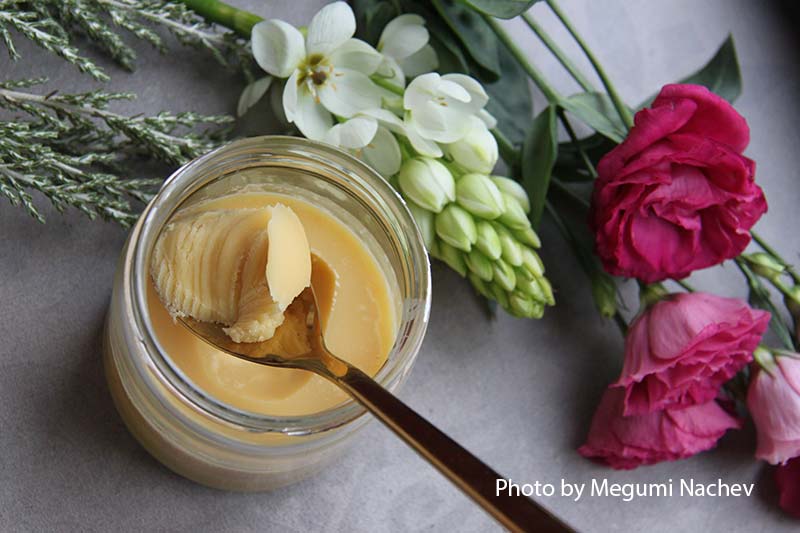Ayurvedic medicine
Ayurvedic texts describe many diverse mind/body benefits. For example,
Absorption: Ghee is an integral part of the practice of ayurvedic herbal formulation. Since ghee is an oil, it can bond with lipid-soluble nutrients and herbs to penetrate the lipid-based cell membranes of the body. It is stated to increase the potency of certain herbs by carrying the active components to the interior of the cells where they impart the most benefit.
Digestion: The ayurvedic texts say that ghee helps balance excess stomach acid and helps maintain/repair the mucus lining of the stomach. Mild Burns: Like aloe, ghee is said to prevent blisters and scarring if applied quickly to the affected skin. Also, ghee stored over a longer time has more medicinal value.
Nutrition and health concerns
Like any clarified butter, ghee is composed almost entirely of saturated fat. Ghee has been shown to reduce serum cholesterol in one rodent study.
Indian restaurants and some households may use hydrogenated vegetable oil (also known as Vanaspati, Dalda, or "vegetable ghee") in place of ghee for economic reasons. This "vegetable ghee" is polyunsaturated or mono unsaturated partially hydrogenated vegetable oil, a trans fat. Trans fats are increasingly linked to serious chronic health conditions. But also, not only is "vegetable ghee" implicated in causing high LDL, it also lacks the health-promoting benefits claimed for "Shuddh" (Hindi for Pure) ghee.
When cooking, it can be unhealthy to heat polyunsaturated oils such as vegetable oils to high temperatures. Doing so creates peroxides and other free radicals. These substances lead to a variety of health problems and diseases. On the other hand, ghee has a very high smoke point and doesn't burn or smoke easily during cooking. Because ghee has the more stable saturated bonds (i.e., it lacks double bonds that are easily damaged by heat) it is not as likely to form dangerous free radicals or advanced glycation end products when cooking.
Ghee's short chain fatty acids are also metabolized very readily by the body, which would seem to negate concerns of its health effects. However, there is significant controversy between traditional oils and modern industrially processed oils. The mentioned fact tends to cloud heavily the facts and issues surrounding oil consumption.
How to make Ghee At Home?
Ingredients: Pure unsalted Butter (NOT margarine) Procedure:
- Heat butter in a saucepan over high-medium heat until it boils or bubbles.
- Reduce the heat to medium-low and cook uncovered until butter turns to a clear golden colour. (Butter usually begins to boils with lots of bubbles. When it is done, it will have foam on top of it indicating that ghee is nearly done.)
The butter will separate into three layers:
- the casein, a frothy layer on top
- the clarified butterfat--the ghee--in the middle
- The milk solids, and proteins in the bottom, which are also useful.
The lactose remains with the watery portion, so ghee can be used to cook for people who are lactose intolerant.
Spoon off the foam from the top of the melted butter.
Filter the rest trough lint into containers in which you will store and cool prepared ghee.
Use it in your cooking.
Source:
Wikipedia
Personal experience


